
Dichanthelium is genus of flowering plants of the grass family, Poaceae. They are known commonly as rosette grasses and panicgrasses.

Stellaria pubera, commonly called the star chickweed, is a spring-flowering plant in the carnation family Caryophyllaceae, native to the eastern United States.

Hypoxis hirsuta, commonly known as common goldstar, common star-grass, eastern yellow stargrass, yellow star grass, or yellow star flower, is a perennial ornamental plant in the family Hypoxidaceae. Sometimes this plant is placed in the family Amaryllidaceae or the family Liliaceae. The species is native to the United States, Canada, and northeastern Mexico.

Schwalbea americana, commonly known as American chaffseed, is the sole species currently classified in the genus Schwalbea. It is an erect, hemiparasitic, perennial herb in the family Orobanchaceae. It is native to the southeastern United States where it is found in wet acidic grasslands. This species has declined tremendously from its historical range due to fire suppression, and it is currently listed as "Endangered" by the U.S. Fish and Wildlife Service.

Isoetes melanospora, commonly known as black-spored quillwort or black-spored Merlin's grass, is a rare and endangered aquatic lycophyte endemic to the U.S. states of Georgia and South Carolina. It grows exclusively in shallow, temporary pools on granite outcrops, often with only 2 cm of soil. 11 populations are known to exist in Georgia, while only one has been recorded in South Carolina, though this population is believed to be extirpated. The number of sites has dropped from 18 following its discovery due to habitat destruction caused by quarrying, trash dumping and trampling. New leaves quickly sprout after fall and winter rains, but during the dry summer months these typically shrivel.
Puccinellia parishii is an uncommon species of grass known by the common names bog alkaligrass and Parish's alkali grass. It is native to the western United States, where it is known from a few locations in Arizona and New Mexico, and one occurrence each in California and Colorado.
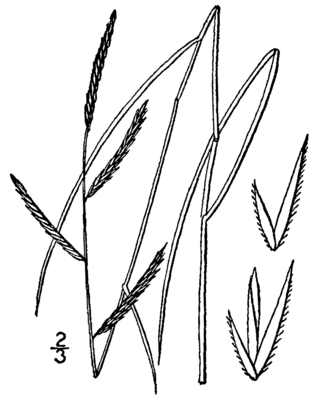
Sporobolus pumilus, the saltmeadow cordgrass, also known as salt hay, is a species of cordgrass native to the Atlantic coast of the Americas, from Newfoundland south along the eastern United States to the Caribbean and north-eastern Mexico. It was reclassified after a taxonomic revision in 2014, but the older name, Spartina patens, may still be found in use. It can be found in marshlands in other areas of the world as an introduced species and often a harmful noxious weed or invasive species.

Cirsium lecontei, often called the Le Conte's thistle, is a North American plant species native to the southeastern United States. It is a perennial, or sometimes biennial, species of the tribe Cardueae within the family Asteraceae. It grows along the coastal plain from Louisiana to North Carolina.

Lysimachia asperulifolia is a rare species of flowering plant in the Primulaceae known by the common name rough-leaved loosestrife and roughleaf yellow loosestrife. It is endemic to the Atlantic coastal plain in North Carolina and northern South Carolina in the United States, where there are 64 known populations. It is a federally listed endangered species of the United States.

Tiedemannia canbyi is a rare species of flowering plant in the carrot family known as Canby's dropwort and Canby's cowbane. It is native to the southeastern United States, where it occurs on the Atlantic coastal plain from North Carolina to Georgia, as well as the Chesapeake Bay area. It is threatened by the loss of the wetland habitat in which it grows. It is a federally listed endangered species of the United States.

Panicum hemitomon is a species of grass known by the common name maidencane. It is native to North America, where it occurs along the southeastern coastline from New Jersey to Texas. It is also present in South America.

Muhlenbergia torreyana is a species of grass known by the common names New Jersey muhly, Torrey's muhly, and Torrey's dropseed. It is native to the eastern United States, where today it occurs in Maryland, New Jersey, North Carolina, and Tennessee. It has been extirpated from Delaware, Georgia, and New York.

Dichanthelium clandestinum is a species of grass known by the common name deertongue. It is native to eastern North America, including eastern Canada and the eastern United States.
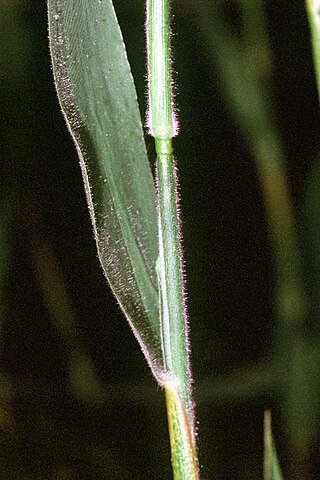
Dichanthelium scoparium is a species of grass known by the common names velvet panicum, velvety panicgrass, and broom panicgrass. It is native to North America, where it occurs in the southeastern United States. It also occurs in the West Indies.
Ruellia noctiflora, the nightflowering wild petunia, is a herbaceous perennial found along the Gulf coast. Both its specific and common names derive from its habit of nocturnal flowering. In spite of the common name it is in a different family from the garden petunia.

Dichanthelium oligosanthes, known as Heller's rosette grass, fewanther obscuregrass, and few-flowered panicgrass, is a frost-tolerant, perennial grass species native to North America. It is found primarily in the contiguous United States with specimens also reported in British Columbia and Alberta in Canada, as well as south of the Rio Grande in northern Mexico. D. oligosanthes is most frequently in partially shaded glens within woods, recently cut forests, and grassy banks.
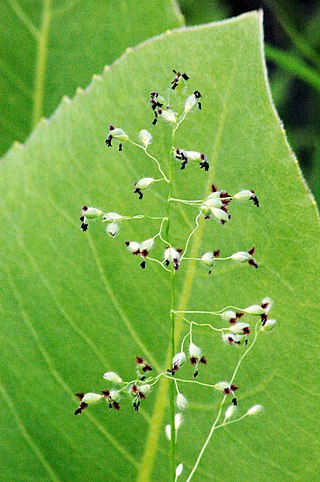
Dichanthelium leibergii, known as variously as Leiberg's panicum, Leiberg's panicgrass, Leiberg's rosette grass, and prairie panic grass is a species of grass native to North America. It was named for its discoverer, John Bernhard Leiberg (1853-1913), a Swedish-born American botanist active in the western United States.

Dichanthelium scabriusculum common names tall swamp rosette-panicgrass, tall swamp panicgrass, rough panic-grass and panic grass, is a species of plant found in North America. It is listed as endangered in Connecticut, Maryland, and New York (state). It is listed as threatened in Massachusetts.
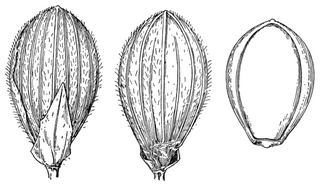
Dichanthelium xanthophysum, formerly known as Panicum xanthophysum, common names slender rosette grass, panic grass and slender panic-grass, is a plant found in North America. It is listed as a special concern and believed extirpated in Connecticut. It is listed as endangered in New Jersey and Pennsylvania.
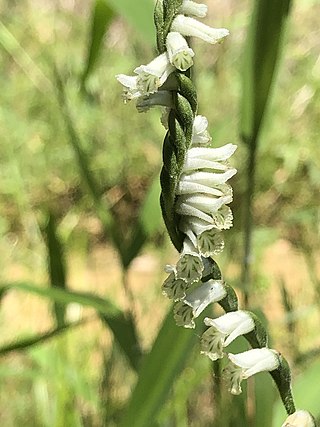
Spiranthes praecox, the grass leaved ladies' tresses, green-vein ladies'-tresses or sometimes giant ladies' tresses is a terrestrial orchid endemic to the United States, growing on the eastern coastal plains and around the Gulf Coast.


















